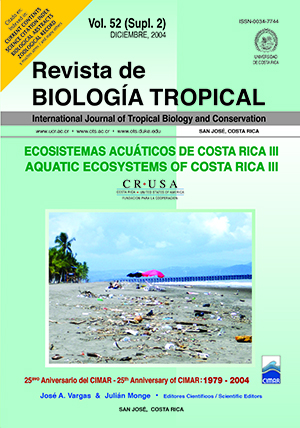Resumen
La abundancia, distribución y composición del macrozooplancton fue estudiada en bahía Culebra Costa Rica (10º 38’ N and 85º 40’ W) en cuatro estaciones durante la época seca (Febrero-Mayo) y lluviosa (Setiembre – Noviembre) del año 2000. Las muestras fueron colectadas en intervalos de dos semanas usando una red de 500μm de poro y 0.50-m de diámetro. Copépodos (23-31%) y ostrácodos (20-34%) fueron predominantes através del año, seguidos por los cladóceros (2.5-14%), zoea (6.6-9.5%), y sifonóforos (2.5-7.2%). Altas densidades de zooplancton fueron obtenidas en Febrero y Marzo, con un pico el 18 de Marzo. Las más bajas densidades fueron observadas el 3 de Septiembre y 5 de Noviembre. Se observaron diferencias significativas en las abundancias en cada estación para los copépodos de la especie Acartia tonsa, los grupos Ctenophora, medusae, Ostracoda, zoea y Amphipoda. Comparando las estaciones seca y lluviosa, significativamente más altas densidades fueron obtenidas en todas las estaciones en la época seca; durante la época lluviosa los ostrácodos dominaron las áreas externas. La abundancia y distribución del macrozooplancton son influenciadas por el afloramiento, el cual ocurre durante la época seca en Bahía Culebra.Citas
Alvariño, A. 1981. Siphonophorae. En: Boltovskoy, D. Atlas del Zooplancton Del Atlántico Sudoccidental y métodos de trabajo con el zooplancton marino. Publicación especial del INIDEP. Mar de Plata, Argentina. 936 pp.
Arfi, R.;G. Champalbert & G. Patrite. 1981. Systeme plantonique et pollution urbaine: an aspect des populations zooplanctoniques. Mar. Biol. 61: 133-141.
Bioindicators of Aquatic Ecosystem Stress. Oak Ridge National Laboratory (ORNL). 19 August 1999 <http://www.esd.ornl.gov/programs/bioindicators/
Borg, I. & R. Groenen. 1997. Modern Multidimensional scaling: theory and applications. Springer-Verlag, New York, Inc. 471 pp.
Calef, G.W. & G.D. Grice. 1967. Influnce of the Amazon River outflow on the ecology of the western tropical Atlantic. II. Zooplankton abundance, copepod distribution, with remarks on the fauna of low salinity areas. J. Mar. Res. 25: 84-94.
Clarke, K.R. & R.N. Gorley. 2001. PRIMER v5: User Manual/Tutorial. PRIMER-E Ltd, UK. 90 pp.
Clarke, K.R. & R.M. Warwick. 1994. Change in marine communities: an approach to statistical analysis and interpretation. National Environment Research Council, UK. 144 pp.
Cushing, D.H. 1995. The long-term relationship between zooplankton and fish. ICES J.mar. Sci. 52:611-626.
Díaz-Zaballa, J. & R. Gaudy. 1996. Seasonal variations in teh zooplankton and in the population structure of Acartia tonsa in a very eutrophic area: La Habana bay (Cuba). J. Plank. res. 18:1123-1235.
Fujita, T.T. & S. Fujuita. 1998. Mystery of El Niño and hurricanes; overview of present, distant past and future. Wind Research Laboratory, University of Chicago. 73 pp.
Glynn, P., E. Druffel & R. Dunbar. 1983. A dead Central American coral reef tract: possible link with the Little Ice Age. J. Mar. Res. 41: 605.637.
Gross, M.G. 1993. Oceanography: A view of Earth. Prentice Hall, Englewood Cliffs. 446 pp.
Haridas, P., Gopala Menon, P. & M. Madhupratap. 1980. Annual variations in zooplankton from a polluted coastal environment. Mahasager-Bulletin of the National Institute of Oceanography. 13(3): 239-248.
Hopcroft, R.R., Roff, J.C. & D. Lombard. 1998. Production of tropical copepods in Kingston Harbour, Jamaica: the importance of small species. Mar. Biol. 130: 593-604.
Huys, R. & G.A. Boxshall. 1991. Copepod Evolution. Ray Soc. London, pp. 1-468.
Jiménez, C. 2001. Arrecifes y ambientes coralinos de Bahía Culebra, Pacífico de Costa Rica: aspectos biológicos, económicos-recreativos y de manejo. Rev. Biol. Trop. 49 (Supl. 2): 215-231.
Landry, M.R. 1977. A review of important concepts in the trophic organization of pelagic ecosystems. Helgoländer wiss. Meer. 30: 8-17.
Lindo, M.K. 1991. The effect of Kingston Harbour Outflow on the zooplankton populations of Hellshire, South-east Coast, Jamaica. Estuarine, Coastal and Shelf Sci. 32:597-608.
Mauchline, J. 1998. The biology of calanoid copepods. Academic Press. San Diego. 710 pp.
Morales-Ramírez, A. & M. Murillo. 1996. Distribution, abundance and composition of coral reef zooplancton, Cahuita National Park, Limon, Costa Rica. Rev. Biol. Trop. 44(2): 619-630.
Peterson, W. 1998. Life cycle strategies of copepods in coastal upwelling zones. J. Mar. Syst. 15: 313-326.
Reeve, M.R. 1970. Seasonal changes in the zooplankton of south Biscayne Bay and some problems of assessing the effects on the zooplankton of natural and artificial thermal and other fluctuations. Bull. Mar. Sci. 20: 894-921.
Riley, G.A. 1967. The plankton of estuaries. P.: 316-326. In G.H. Lauff. (ed.). Estuaries. American Association for the Advancement of Science. Washington, D.C.
Rippe, L. 1996. Gemeinschaftsanalyse des Küstennahen Mesoplankton im Flachwassergebiet vor der Kolumbianischen Pazifikküste. Diplomarbeit. Universität Bremen.
Tester, P.A., Turner, T.T. & D. Shea. 2000. Vectorial transport of toxins from the dinoflagellate Gymnodinium breve through copepods to fish. J. Plank. Res. 22: 47-61.
Vandermeulen, H. 1998. The development of marine indicators for coastal zone management. Ocean & Coastal Management 39: 63-71.
von Wangelin, M. & M. Wolff. 1996. Comparative biomass spectra and species composition of the zooplankton communities in Golfo Dulce and Golfo de Nicoya, Pacific Coast of Costa Rica. Rev. Biol. Trop. 44 Suppl. (3): 85-105.
Wallace, J.M. & P. V. Hobbs, 1977. Atmospheric Science - An Introductory Survey. Academic Press, New York. 467 pp.
Wetzel, R.G. & G.E. Likens. 1991. Limnological analyses, 2nd ed. Springer-Verlag, Dubuque, New York.
Whitledge, T.E. 1981. Nitrogen recycling and biological populations in upwelling ecosystems, p.257-273. In F.A. Richards [ed.], Coastal Upwelling. Am. Geophys. Union.
Wyrki, K. 1964. Upwelling in the Costa Rica Dome. Fish Bull. 63: 355-372.
Youngbluth, M.J. 1980. Daily, seasonal, and annual fluctuations among zooplankton populations in an unpolluted tropical embayment. Estuarine and Coastal Mar. Sci. 10: 265-287.
Comentarios

Esta obra está bajo una licencia internacional Creative Commons Atribución 4.0.
Derechos de autor 2004 Revista de Biología Tropical


